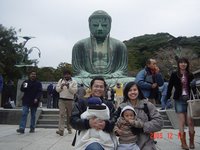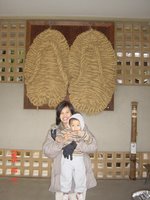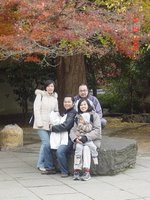


By the way, about this big Budha in Kamakura is very special, eventhough there are 3 Big Buddha statues in Japan; Kamakura, Kyoto and Nara. Among those three ,the one in Kamakura (Kamakura Daibutsu, Dai=big, Butsu= Buddha) is the only one which remains in its original form.
How big is this metal statue? Well,… 15 meters in height (the face itself nearly 2.5 meters long), and 93 tons in weight. Upon the head are 656 hair curls, a traditional characteristic of the Amida Buddha. The silver boss on the forehead (from which emanates the light that illuminates the universe) weighs 30 pounds.
It is said that the one in Kamakura is actually the statue of Amida Nyorai (Amithaba--in Sankskrit) who was known as Hozo Bodhisattva (Skt. Dharmakara). Some people believe that by chanting his name : "Namu Amida Butsu" with utmost sincerity they will rebirth in the pure land and attain enlightment (free from the cycle of birth and death).
The interesting point is that this statue is worshipped to ward off calamities that occur in the "unlucky ages"(yakudoshi in Japanese); according to the Japanese, the years especially prone to misfortune for men are 25 and 42, and for women 19 and 33. (hey , aji and ibu will turn 33 next year--so probably we should go there next year before we leave for Indonesia)
 We saw a pair of giant sandals hanging on the wall , but unfortunately we could not take pictures conveniently as it turn out to be the background decoration of the smoking area and we have to squeeze ourselves in among those smokers ..uhuk..uhuk...uhuk!!!
We saw a pair of giant sandals hanging on the wall , but unfortunately we could not take pictures conveniently as it turn out to be the background decoration of the smoking area and we have to squeeze ourselves in among those smokers ..uhuk..uhuk...uhuk!!! There are such a crowd visiting temples during autumn. Do you wonder why? it's not that they have the urge to save their prayer, well..some of them do come there for that.. but they are more interested in enjoying the koyo.
There are such a crowd visiting temples during autumn. Do you wonder why? it's not that they have the urge to save their prayer, well..some of them do come there for that.. but they are more interested in enjoying the koyo.  Koyo is beatiful leaves which are as beautiful as the sakura or cherry blossoms during the spring. It might sound familiar to go to the gardens to see leaves but why going to the temples? The answer is the temples plant a lot of trees such as mamoji (japanese maple trees) and ichou trees (ginkgou biloba trees).
Koyo is beatiful leaves which are as beautiful as the sakura or cherry blossoms during the spring. It might sound familiar to go to the gardens to see leaves but why going to the temples? The answer is the temples plant a lot of trees such as mamoji (japanese maple trees) and ichou trees (ginkgou biloba trees). This is called ichou (japanese) or ginkgou trees. Ginkgo is considered the oldest tree species to survive on earth, with a history dating back over 200 million years. Yes you've probably have heard "ginkgou biloba" many times in certain ads on vitamins/supplements. These are the leaves which have been used in chinese medicine for various reasons: to treat skin and head sores as well as freckles, lower serum cholesterol levels and have some clinical value in angina pectoris, to improve short term memory, to treat the erectile dysfunction patients (oops!!) .The seeds are used as an astringent for the lung, to stop asthma, enuresis, and excessive leucorrhea. It is thought to benefit ch'i (qi; vital energy), cough, and regulate urinary frequency. The trees are good for environment as they are long-lived , remarkably resistant to disease, pests, and fires. They also are extremely tolerant of air pollution, and are often planted in harsh city environments where most trees will not survive.
This is called ichou (japanese) or ginkgou trees. Ginkgo is considered the oldest tree species to survive on earth, with a history dating back over 200 million years. Yes you've probably have heard "ginkgou biloba" many times in certain ads on vitamins/supplements. These are the leaves which have been used in chinese medicine for various reasons: to treat skin and head sores as well as freckles, lower serum cholesterol levels and have some clinical value in angina pectoris, to improve short term memory, to treat the erectile dysfunction patients (oops!!) .The seeds are used as an astringent for the lung, to stop asthma, enuresis, and excessive leucorrhea. It is thought to benefit ch'i (qi; vital energy), cough, and regulate urinary frequency. The trees are good for environment as they are long-lived , remarkably resistant to disease, pests, and fires. They also are extremely tolerant of air pollution, and are often planted in harsh city environments where most trees will not survive. this one is called Mamoji(japanese) or maple trees(Acer Palmatum). There are actually 3 kinds of japanese maple trees. the colors change as the season changes.
this one is called Mamoji(japanese) or maple trees(Acer Palmatum). There are actually 3 kinds of japanese maple trees. the colors change as the season changes.Hmmm.. as the winter is coming, we are hoping that snow will fall in yokohama at least for one fine day to take pictures. :}
No comments:
Post a Comment